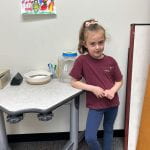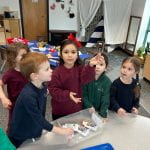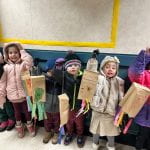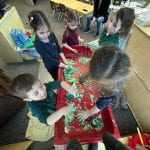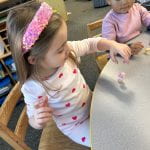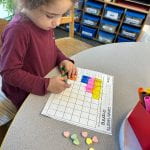“Bees are nature’s magicians.”
Insects. This week, we looked at pictures of different critters and, depending on their anatomy, determined if the critters were, in fact, insects or not. Some critters seemed pretty weird, and others were very peculiar and had unique features, like the acorn weevil (a type of beetle with a snout) or the walking stick that looks precisely like that, a stick that walks. (If you have never seen any of these insects, we highly encourage you to look them up, we think they are the cutest!) Through observation and discussion, we concluded that Ants, the Acorn weevil, the Earwig, the Walking stick, the Praying mantis, the Silverfish, and the Cockroach are, in fact, insects, while the Centipede and Millipede are not. Our curiosity went beyond the classroom as we found critters in the playground, the sidewalk, and the hallways! This activity was not just about identifying critters; it was about developing critical thinking skills, understanding scientific classification, and appreciating the vast diversity of life forms on our planet. By engaging in hands-on exploration, our little ones learn to observe closely, analyze features, and draw informed conclusions.
Our mystery insects are thriving in their larval stage, growing larger and revealing their distinct features, particularly the spots on their backs. This detailed observation has allowed our students to gain a deeper understanding of the unique characteristics of these insects as they progress through their life cycle. While comparing the insects to the larva stage of the butterfly, students concluded that they are definitely not butterflies as the butterfly larva (caterpillar) looks very different. We look forward to sharing more updates as our mystery insects progress through their life cycle.
Service project. Our Bee Keepers sale was a huge success! Our effort paid off, and we reached our goal of one thousand dollars! We had our “Bee Kind” T-shirt raffle, and the lucky winner was Elektra from Ms. Anna’s class. Woohoo! We couldn’t be prouder of our little philanthropists; they were involved every step of the way. Some proudly welcomed our shoppers, offered raffle tickets, and gave them a note to remind them to plant flowers for bees. Thank you all for supporting this great cause.
Bees. After reviewing the anatomy of Bees, each student made a bee using popsicle sticks and pipe cleaners. It was tricky for some because it required a lot of twisting and bending. Students added a head, thorax, abdomen, six legs, five eyes, wings, stinger, and antennas to their bees. Once our bees were ready, we played a freeze-pollination game. We made big flowers full of pollen (chalk dust) that our bees visited while music played. When the music stopped, students were supposed to freeze and continue when the music started again. At the tune of the fun classical song, The Flight of the Bumblebee by Rimsky-Korsakov, students “flew” their bees around our pretend garden, making a buzzing sound and drinking nectar from each flower. Students noticed how the pollen stuck to the fibers of the pipe cleaners, just like natural pollen sticks on bees. At the end of the game, we checked our flowers and saw how the “pollen” had mixed up from one flower to another. We had so much fun pretending to be bees!
On Thursday, we went back to Centennial Park, our first trip there this Spring. We were surprised to find the park full of beautiful dandelions when we got there. As we returned to school, students noticed a stark contrast in the neighborhood lawns, which were mostly bare except for the occasional lonely dandelion. This observation led to a deeper conversation about why dandelions were abundant in the park but sparse in nearby lawns. Students deduced that chemical treatments on lawns might be responsible for the lack of these flowers, which are often dismissed as mere weeds. “We gotta tell them to stop spraying chemicals!” So now we are thinking of ways to tell our neighbors about the importance of dandelions in our garden. Together, we can foster a community that values and protects its natural resources.
Ms. Ela’s babies. We visited Ms. Ela’s class to check out their egg incubator. The experience left our students in awe as they observed the miracle of life inside the eggs, with baby chicks starting to move within their shells. How cool is that? Our students observed the egg incubator in action, which gently rotates the eggs every hour. This rotation is crucial for the development of the chicks inside the eggs. Ms. Ela explained that chickens naturally rotate their eggs three times a day to ensure even heat distribution, prevent the embryos from sticking to the eggshell, and promote healthy growth. We can’t wait to see the baby chicks!
Secret project. As you already know, we are preparing a special day for our moms. While we can’t reveal all the details yet, we assure you that you will love it. Stay tuned!
Efi and Soraya


















